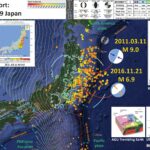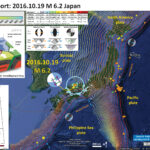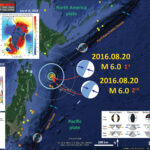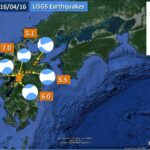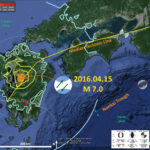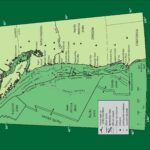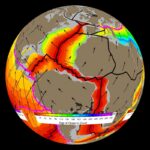While I was returning from my research cruise offshore of New Zealand, there was an earthquake offshore of Japan in the region of the 2011.01.11 M 9.0 Tohoku-Oki Earthquake. Japan is one of the most seismically active regions on Earth.…
Earthquake Report: Japan!
There was an earthquake in Japan tonight (tomorrow morning there). Here is the USGS website for this M 6.2 earthquake. The earthquake was shallow and widely felt with moderate intensity, so some casualties are expected. In the map below I…
Earthquake Report: Japan!
There continue to be earthquakes probably related to the 2011.03.11 Tohoku-Oki M 9.0 earthquake (the 4th largest earthquake recorded on modern seismologic instruments). Here are two excellent summary Earthquake Report pages associated with this region: The original Earthquake Report for…
Earthquake Report: Japan Update #2
Here is an update to the seismicity from the past couple of days in Kyushu Japan. On 2016/04/14 there was an earthquake with magnitude M 6.2 that initiated this series of earthquakes. The largest aftershock was a magnitude M 6.0.…
Earthquake Report: Kyushu, Japan!
As I was preparing an aftershock map for yesterday’s earthquake, an earthquake with a magnitude of M = 7.0 happened. This turns all other earthquakes into foreshocks, though this terminology may not really be important (foreshock vs aftershock). The M…
Earthquake Report: Kyushu, Japan!
We just had a shallow depth earthquake in Japan along a strike-slip fault. Here are the USGS websites for the larger earthquakes in this region for today. 2016.04.14 M 6.2 2016.04.14 M 6.0 2016.04.14 M 5.3 Below is the Earthquake…
Cascadia subduction zone: 316 years ago tonight!
In commemoration of the last known Cascadia subduction zone earthquake, I present a summary background material here. Since last years commemoration, there have been a few additions. I made some updates on 2018.01.26. Most notably was a pair of articles…
Plate Tectonics: 200 Ma
Gibbons and others (2015) have put together a suite of geologic data (e.g. ages of geologic units, fossils), plate motion data (geometry of plates and ocean ridge spreading rates), and plate tectonic data (initiation and cessation of subduction or collision,…
another northeast Japan earthquake in the Tohoku-Oki earthquake region
We have had another small aftershock. Here is the USGS web page for this earthquake. This time it is in a different region than the swarm of the past couple of weeks. There are several report updates, listed here: 2015.02.16…
Tohoku-Oki aftershocks are in a region of low slip during main events in 2011
Here is what I was getting at in my last post. I have taken the Ammon et al. (2011) slip model and placed it into a real world reference frame (rubbersheeted it in ArcGIS). Then I exported it as a…

